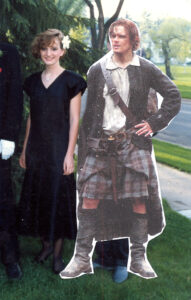I opened my computer yesterday morning to check email and the Comcast headlines assaulted me. Developing story. Stabbing rampage at a high school. I had two thoughts initially: 1) Oh no. Here we go again. 2) Thank goodness it wasn’t a gun.
I should’ve prefaced this post with the caveat that I am not an expert on anything relevant. I’m not a sociologist or a psychologist or a school guidance counselor or a police officer. I am a human and a mother. Hear me out if you will.
A couple days ago, Ace and I engaged in a lengthy discussion regarding cultural appropriation, precipitated by Robin Wood’s blog post. A woodworker by trade, the author debates whether a craftsperson should make and sell art that originated within another cultural heritage. Is it ethical for me to create and market Hindu Vajra for my own profit? Is it appropriate for me to wear a sari? How about a Plains Indian headdress? Do the Cleveland Indians, Washington Redskins, and Atlanta Braves exploit or respect American Indian cultural traditions?
Ace argued that he and I lack a distinctive cultural heritage. My ancestors came from all over Europe and parts of the UK. His hail primarily from Great Britain. So borscht, sheepherding, dreidels, escargot, Erzgebirge nutcrackers, kilts, samovars, and the Eiffel Tower are all fair game for us in terms of cultural appropriation.
What constitutes contemporary American culture? My cynical self, the one who monitored the developing story, says that the US is defined by fast food, selfies, reality television, and violence. Welcome to America, here’s your diabetes. Be sure to purchase your assault weapon before the enactment of new gun control legislation.
According to Forbes, Divergent pulled in over $100 million in two weeks. Catching Fire topped $160 million in its opening weekend. Once you move past the initial euphoria (“Hey! It’s a strong female protagonist!”), you settle down into the comfortable familiarity of yet another violent film targeted at children. Gender equity means girls get to kill people, too. Yippee.
One of my high school friends drove up from Chicago with her kids last weekend and we used it as an excuse to get the old gang back together. The husbands dragged the passel of children to the park while the wives drank tea and discussed children’s and Young Adult literature.
I grow weary of violent books. It took me several days to physically recover from reading the Divergent series. The relentless killing (including an eleven-year-old boy shot at point-blank range) sucked the life force out of me, rendering me incapable of higher cognitive function. I told my girlfriends, mostly for the sake of argument, that I want to write a book about a realistic, loving, sexual relationship between two well-adjusted teenagers. Hm, they said. Do you think there would be a market for that? Nope.
I lull myself into a false silver lining; At least it wasn’t a gun. The twenty-one people who were stabbed yesterday morning are all expected to live. So that means a boy grabbed two knives, perhaps the longest ones he could find in his own kitchen, traveled to school, and then proceeded to repeatedly slash and stab his classmates, lifting the weapons and plunging them into abdomens and chests and faces.
Virtually the only study I recall from my Intro to Psychology textbook is Albert Bandura’s Bobo doll experiment. Kids who watched an adult physically and verbally abuse the Bobo doll were more violent toward the doll in subsequent interaction than kids who did not witness violence.
I agree that kids should learn how to read, write coherent sentences, and solve math problems. But how about modeling conflict resolution and healthy collegial relationships or teaching kids how to engage in difficult conversations? You can’t graduate from high school unless you log 125 acts of kindness and 75 volunteer hours. Every violent video game would be peppered with additional scenarios: rescuing dogs from burning buildings, emotion management exercises, and yanking toddlers from the path of oncoming cars.
We send our children into the arena every day. How do we arm them? With anger and poor impulse control and knives and inadequate medical care and homelessness and narcissism and guns? Or with nutritious food, literacy, compassion, access to mental health services, love, interpersonal skills, adequate sleep, and empathy.
Let’s choose the path that allows our youth to create a contemporary American culture worth appropriating.



















